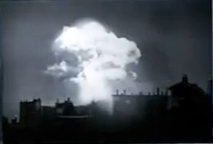| This 1983: Doomsday page is an obsolete proposal. Information in this article is not part of the 1983: Doomsday timeline. The page has been saved for reference purposes. You can comment on this page's talkpage. |
| |||||||
| Capital | Bender | ||||||
| Largest city | Bender | ||||||
| Other cities | Tiraspol (being rebuilt), Chisinau (currently destroyed) | ||||||
| Language official |
Russian, Moldavian | ||||||
| others | Ukrainian, Romanian | ||||||
| Religion | Eastern Orthodox | ||||||
| Demonym | Transnistrian | ||||||
| Legislature | Supreme Soviet | ||||||
| Population | Approx. 42,000 | ||||||
| Independence | from Moldovan SSR, Soviet Union | ||||||
| declared | 1983 | ||||||
| Currency | Transnistrian Rouble | ||||||
The Socialist Republic of Transnistria, also known as the Pridnestrovian Moldavian People's Republic, is a post-Soviet survivor state based around the banks of the Dniester River and the former Moldovan SSR.
History
Post-Doomsday
Transnistria declared independence in 1983, several days after they had received word that a nuclear war had just occurred between the Soviet Union and the United States. The interim government declared martial law in preparation for the hordes of refugees they thought would come, but to their surprise few managed to reach the fledgling nation.

The Nuclear Cloud that destroyed Tiraspol.
The capital Tiraspol was hit by a relatively small nuclear strike, but the fallout from nearby strikes, like Chisinau and Odessa, hurt the nation strongly as well. Immediately after the strikes occurred, many of the survivors got sick and the few hospitals remaining did not have the staff or supplies to treat the majority of them. Only martial law held what was left of the area together.
The region only became truly stable in 1999, when martial law was lifted and the radiation decrease reduce the amount of radiation sickness in the populace.
Government
The government is officially a Communist republic, however several private industries exist throughout the country and the capital Tiraspol. Political parties are allowed under the constitution, however most of the Supreme Soviet is held by the Communist Party of Transnistria. Senatorial elections are held every two years, however vote-rigging is a constant problem.
The general stability of the country and the government's success at increasing the prosperity of the people has resulted in relatively low amounts of political and ethnic violence
Foreign Relations
Transnistria has foreign relations with most of Europe and several countries of Asia. Transistria also has very strong relations with the USSR, but some politicians advocate distancing themselves from the Soviets and focus on unifying the Romanian/Moldovan people.
A major foreign issue is the status of former Moldova, and tensions between Transylvania and Transnistria are quite high over it after they fought a war over the issue. Currently Transylvania blocks Transnistria from joining the League of Nations.
Military
The military of Transnistria is divided into three sections, the Army, the Navy, and the Air Force. The Army is the largest part of the Military, and is responsible for the defense of the nation and achieving local domination.



